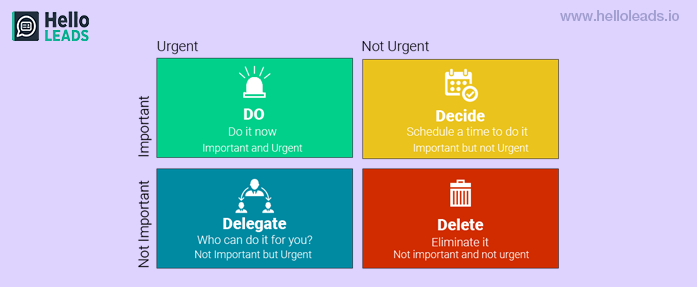
How powerful is your to-do list? Does it assist you to plan your day? Or is it an endless list of tasks that you feel guilty for not completing yet?
One key factor that is useful for time management is to prioritize your list of tasks. To prioritize is to organize or get things done in the order of their importance.
One of the most common interview questions is “How do you prioritize your work?” “Every morning, I write out my chores to be performed, and I list them from high to low priority according to how important they are. This allows me to concentrate on the mission at hand,” is an example of a straightforward answer to this question. Is there any effective way to prioritize our work? Here is a two-step approach to efficiently prioritize your work.
Two simple steps to prioritize your work efficiently:
1. Make a complete list of all your tasks
Make a to-do list that includes everything you could possibly conceive of doing in a day. Don’t be concerned about the order or number of tasks at this time. Make this list on a daily basis, such that the work that matters most to you are clearly listed out and nothing is missed out.
As soon as a new assignment or task comes to your mind, jot it down as soon as feasible. You can use a Notepad App on your laptop for this purpose or a variety of mobile apps that are available in your phone. Even a physical diary or notepad will do as long as it helps you not to forget your high-priority items.
2. Place the tasks in Eisenhower matrix / Priority matrix
Eisenhower matrix / Priority matrix is a time management matrix, which helps you to organize your responsibilities / tasks more efficiently. It is named after Dwight D. Eisenhower, the 34th president of the United States who is known for his organizational skills. It is a task management tool that assists you in distinguishing between urgent and significant jobs in order to create an efficient workflow.
What do you mean by urgent tasks?
Urgent tasks require your immediate attention. These are tasks that you can’t avoid, and the longer you delay these tasks, the more stress you might experience.
What do you mean by important tasks?
Important tasks do not require immediate attention, but these help you to achieve your long-term goals.
Once you have sorted between urgent and important tasks, you can begin separating your tasks into these four quadrants.

First quadrant: Do
Any tasks that are both urgent and important should be placed here. Place a task in this quadrant when you see one on your to-do list that needs to be completed right away, has clear consequences if not completed right away, and has an impact on your long-term goals.
There should be no question about which tasks go here because they are at the front of your mind and are likely stressing you the most.
Second quadrant: Decide
Place any tasks that are not urgent but are still important. Because these tasks affect your long-term goals but don’t need to be done immediately, you can schedule these tasks for later.
Third quadrant: Delegate
Any tasks that are urgent but not critical should be placed here. These chores have to be completed now, but they don’t affect your long-term objectives. You can assign such tasks to other members because you don’t have a personal attachment to these tasks and your specialized skill set may not be required to perform them.
Fourth quadrant: Delete
Once you’ve gone through your to-do list and added tasks to the first three quadrants, you will have just a handful of tasks that are leftover. These unimportant, non-urgent items are simply distractions that need to be deleted if you want to achieve your objectives.
This way you can effectively manage your time by clearly setting the objective, prioritising the important tasks and do away with the unnecessary and redundant tasks. Effective time management skill is an asset by itself in reducing your stress levels and achieving success with ease.
Some useful tips for Easy prioritization and Time management:

1. Put tasks on your lists, rather than objectives and goals.
2. Identify the competing priorities and deal with them. Competing ideas or interests are priorities that cannot be satisfied at the same time. The best way to manage such conflicting priorities is to stay calm, be logical, and most importantly have a proper system.
3. Categorize your professional and personal to-dos. To avoid over-lapping commitments, make separate matrices for your professional and personal tasks.
4. Try limiting yourself to no more than eight tasks per quadrant. Before adding another one, ensure that you complete the most important one first. Try to remember that it is not about collecting but finishing tasks.
5. Assign due dates to your tasks. Plan effectively for your week ahead
6. Priorities can shift unexpectedly. Try to limit the number of daily tasks to save time in the event of any adjustments that need to be made.
7. Establish a Structured “No Work” Time.

Susan Wojcicki, the CEO of YouTube, has made it a rule not to check her emails between the hours of 6 p.m. and 9 p.m. She was the first woman to request maternity leave when Google was just getting established, according to a business story. Establishing a no-work time will allow you to replenish your energy levels for the upcoming task.
8. Feeling Lost in one priority.
During the day, if you get lost in what you’re doing or need a break from it, check through your to-do list for something little and simple that you can do in the meantime. Checking items off your list provides you with a sense of satisfaction and is an excellent way to get organized.
Conclusion :
Prioritizing work ensures your success in all spears of your life and also helps in taking time for your family and other important relationships in your life.
So, what are you waiting for? Getting started may be tricky, but with some practice using the prioritization matrix, you’ll find that you have mastered the art of execution and learned a great life hack.
Share this blog :











Leave a Reply